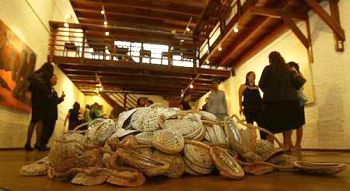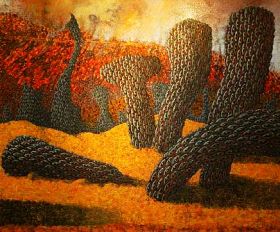The Star, 23 February 2007
Tasmania for all to see
by Lim Chia Ying
THE splendours of Tasmania, an island in mainland Australia, is a must-see place if the pictures are anything to go by.
Its wild coastline, picturesque valleys, uninhabited highland reaches and rugged mountains as well as bush land are inviting.
Who can resist a place that offers so much? Not even the artists, it seems.
Tasmania’s contrasting landscapes, rich history and traditions have become an inspiration to seven artists residing in Tasmania.
Philip Wolfhagen, David Stephenson, Richard Wastell, David Keeling, Bea Maddock, Jonathan Kimberley (in collaboration with poet Jim Everett) and Julie Gough – have all created different modes of artwork displayed in an exhibition themed From An Island South that is going on tour in different countries.

Ingenious: Return (2005)by Gough is a creation of a string of abalone shells tied together with a rope.
The exhibition is currently held at the Wei-Ling Gallery in Brickfields, presented in partnership by Devonport Regional Gallery and the Asialink Centre of the University of Melbourne.
Gough’s creation, Return (2005) is an ingenious string of abalone shells tied together with a rope.
This is a magnified version of traditional aboriginal necklaces made from tiny shells collected by aboriginal women.
Driven by her roots as a descendant of the Tasmanian indigenous community, the artist offers glimpses into her rich heritage through the necklaces, which are the only continuing aboriginal tradition in Tasmania.
Devonport Regional Gallery director Jane Stewart, who is also the exhibition’s curator said the seven artists were selected based on their ability to showcase a contemporary Tasmania to an international audience.
“These works were displayed in Pakistan prior to here, after which it will continue in Taipei and Thailand,” said Stewart.

Colourful: An artwork by Richard Wastell entitled Not Far From Here, Burnt Manferns and Firebombed Forest, Styx Valley 2005 using oil and marble dust on linen.
Wastell’s painting of Last Night I Dreamed An Island Gentle (2003) takes viewers into the heart of Tasmanian forests filled with ancient trees and lichen moss, exposing the vulnerability of the forest and its fragile place within Tasmanian’s landscape.
An interesting take is The Diminishing Paradise II (1995) by Keeling, who has cleverly combined the conflicting elements of Tasmania, from conservation on one end and modernisation on the other, onto miniature dioramas.
These dioramas provide multi-faceted images of the island’s main highway, a historic house, the Pink Panther and the night sky, among others.
Keeling said through this creation, he is questioning the struggle to cope with the old and new ways of life on the island, the changes that are taking place and the diminishing wilderness due to rapid development.
Another painting that stands out is Leaving A Mountain (1992-93) by Maddock, created using graphite, oil stick, and encaustic on canvas.
The piece, measuring six metres, is divided into eight panels, each with a successive aspect of the mountain drawn in calligraphic lines.
The outgoing Australian High Commissioner to Malaysia, James Wise, launched the exhibition.
“I think these paintings speak very well for themselves – people can see what Tasmania is like today,” said Wise.
“Contrary to beliefs that it is a small island, Tasmania is in fact slightly larger than Sri Lanka!” he said.
The exhibition is being held until tomorrow.
For details, call 03-2260 1106 / 017-887 7216.

